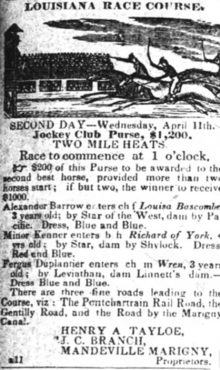
Metairie is a census-designated place (CDP) in Jefferson Parish, Louisiana, United States, and is part of the New Orleans metropolitan area. With a population of 143,507 in 2020, Metairie is the largest community in Jefferson Parish and was the fifth-largest CDP in the United States. It is an unincorporated area that would have been Louisiana's fourth-largest city behind Shreveport if incorporated.

Metairie Cemetery, is a cemetery in southeastern Louisiana. The name has caused some people to mistakenly presume that the cemetery is located in Metairie, Louisiana, but it is located within the New Orleans city limits, on Metairie Road.

Eclipse was an undefeated 18th-century British Thoroughbred racehorse who won 18 races, including 11 King's Plates. He raced before the introduction of the British Classic Races, at a time when four-mile heat racing was the norm. He was considered the greatest racehorse of his time and the expression, "Eclipse first, the rest nowhere" entered the English vernacular as an expression of dominance.

Potoooooooo or variations of Pot-8-Os was an 18th-century thoroughbred racehorse who won over 25 races and placed higher than some of the most prominent racehorses of his time. He went on to be an important sire, whose leading runners included Epsom Derby winners Waxy, Champion, and Tyrant. He is best known for the unusual spelling of his name, pronounced Potatoes.

Fair Grounds Race Course, often known as New Orleans Fair Grounds, is a thoroughbred racetrack and racino in New Orleans, Louisiana. It is operated by Churchill Downs Louisiana Horseracing Company, LLC.
The Louisiana Derby is a Grade II American Thoroughbred horse race run annually at the Fair Grounds Race Course in New Orleans, Louisiana. Run in late March, the race is open to horses, age three, willing to race 1+3⁄16 miles on the dirt. It currently offers a purse of $1,000,000.

Fashion (1837–1860) was a Thoroughbred four-mile racemare that defeated Boston and set a record of 7:32½, for that distance, before the American Civil War. Until her meeting with Peytona, Fashion had started 24 times, and won 23 races, 14 of which were of four-mile heats, 6 of 3-mile heats and 3 of 2-mile heats for earnings of $35,600.

Jean-Bernard Xavier Philippe de Marigny de Mandeville (1785–1868), known as Bernard de Marigny, was a French-Creole American nobleman, playboy, planter, politician, duelist, writer, horse breeder, land developer, and President of the Louisiana State Senate between 1822 and 1823.

Mollie McCarty foaled in 1873, was an outstanding California-based Thoroughbred racehorse who won her first 13 race starts and was second on the two occasions when she was defeated.

Sir Archy was an American Thoroughbred racehorse considered one of the best racehorses of his time and later one of the most important sires in American history. He was inducted into the National Museum of Racing and Hall of Fame in the inaugural class of 1955.
Master Derby was an American Thoroughbred racehorse best known for winning the 1975 Preakness Stakes.
The media of New Orleans serve a large population in the New Orleans area as well as southeastern Louisiana and coastal Mississippi.
Young Eclipse was a Thoroughbred racehorse that won the 1781 Epsom Derby. He raced until he was six years old, winning seven races and retiring to stud in 1785. He was not a successful sire.

Henry Augustine Tayloe was an American planter, slaveholder, horse breeder and racer, and land speculator in Alabama during the 19th century.
The Washington Jockey Club was an American association in Washington, D.C. devoted to horse racing, founded in 1797. The club established its first racecourse four blocks from the Executive Mansion where it extended from 17th and 20th Streets and extending across Pennsylvania Avenue into Lafayette Park, what is now the site of Decatur House at H Street and Jackson Place, crossing Seventeenth Street and Pennsylvania Avenue to Twentieth Street, largely on the site of today’s Eisenhower Executive Office Building. The course was relocated in 1802 to the Holmead Farm two miles north of the Executive Mansion, to what is now Meridian Hill.

The Boston Club is a segregated private gentlemen's club in New Orleans, Louisiana, US, founded in 1841 as a place for its white members to congregate and partake in the fashionable card game of Boston. It is the third oldest City Club in the United States, after the Philadelphia Club (1834) and Union Club of the City of New York (1836). The clubhouse has been located at 824 Canal Street since 1884, formerly 148 Canal St, on the edge of the Central Business District; built in 1844 by James Gallier as a city residence for Dr. William Newton Mercer, a planter in Mississippi and surgeon from the War of 1812. The Club itself was organized in 1841 by thirty leading mercantile and professional men, they were the heads of families and men of substance on the shady side of life, yet full of bonhomie and fond of the card game of Boston from which this club was christened. It epitomized the South's most refined male tastes and attitudes, a member once noted, "Propriety of demeanor and proper courtesy are alone exacted within its portals."
Leviathan (1823-1846) was a British Thoroughbred racehorse who won 16 of 21 starts before injury prompted his retirement. Imported into Tennessee in 1830, he was the leading sire in North America of 1837, 1838, 1839, 1843 and 1848, and also finished second five times. He was also an important broodmare sire, with modern descendants through the female line including Affirmed, Alydar and Dance Smartly.
The Eclipse Race Course was the third formal thoroughbred horse racing track in New Orleans, Louisiana, founded in 1837 by Captain Yelverton Oliver, who owned the famous thoroughbred Richard of York; a native Virginian, who organized The New Orleans Jockey Club.
The Bascombe Race Course is a former thoroughbred horseracing track in Mobile, Alabama, built in 1836 that hosted The Mobile Jockey Club.

The Mobile Jockey Club was an American sporting organization founded prior to 1836 in Mobile, Alabama.
















